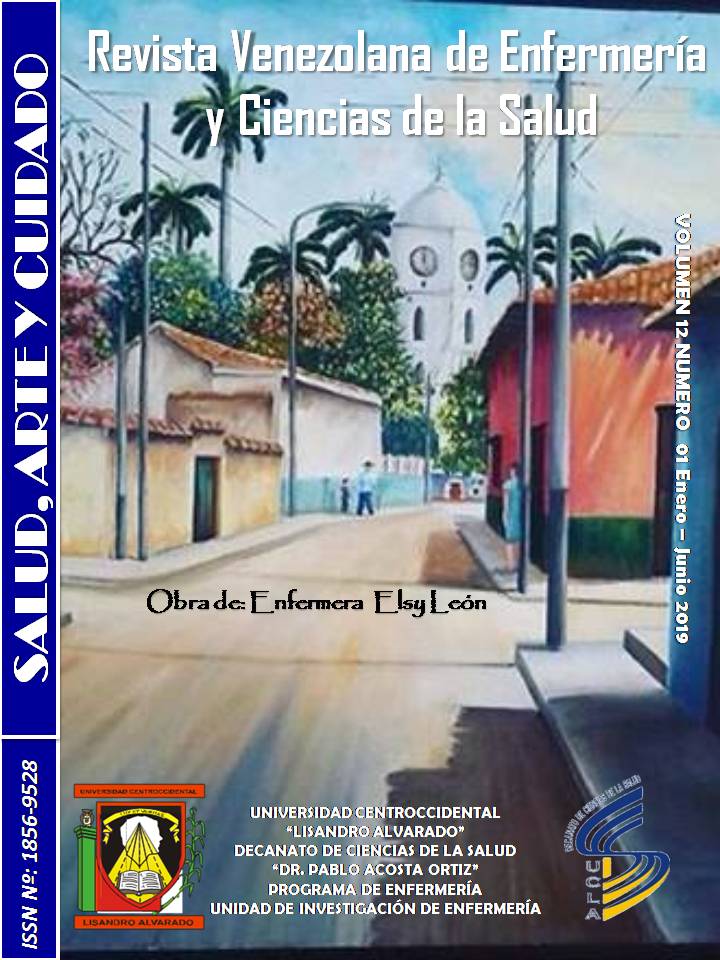How do patients perceive the treatment of nurses in the hospital emergency?
Keywords:
treatment, patients, nursing, emergencyAbstract
Objective: To analyze the treatment received by the patient by the nursing staff in the emergency unit of the Central University Hospital Dr. Antonio Maria Pineda. Methodology: This study is based on a quantitative, non-experimental method, supported by a descriptive cross-field design. The population consisted of 112 patients, all older than 18 years of both sexes, who met the respective conditions, with healthy mental and cognitive functioning, who entered the emergency unit for three days a week in the morning shift for about two weeks. As a technique, the interview was used and a survey-type instrument structured by 5 dimensions was used, which correspond to sociodemographic data, patient reception, and pathophysiological condition of the patient, influencing factors and strategies, to respond to 30 items which has to do with a Likert-type scale. Conclusion: the majority of the patients demonstrated agreement regarding the treatment they receive from the nursing staff, highlighting that the majority disagreed with the fact that the nursing staff greets each patient in a friendly manner, and the majority stated that the nursing staff does not take into account the severity of the patient to be cared for. However, most of the surveyed patients fully agreed that the excess of patients affects nursing work.
Downloads
References
2. Torrealba, F. Antropología del Cuidar. [Libro en línea]. Limusa Editores. 5ta edición. España: Fundación Mapfre Medicina; 1998. 99-106pp. Disponible: https://www.iberlibro.com/antropología-cuidar-torralba-roselló-francesc/22840436756/bd
3. Nava, M.Trato digno otorgado por enfermeras en centros de salud en Morelos, México. Rev. Enf IMSS.2011; 19 (2): 2002. 91-98 [Revista en línea]. Disponible: https://www.redalyc.org/pdf/1270/127044052007.pdf
4. Código Deontológico del CIE para la Profesión de Enfermería. (2005). Ginebra, Suiza. 2005. Disponible: http://www.ee.lafe.san.gva.es/pdfs/icncodesp.pdf
5. Alférez, A. La comunicación en relación de ayuda al paciente en enfermería.Dialnet. 2012 ;(3); 147-157 Disponible:http://www.Users/electronica/Downloads/Dialnet
6. Fernández, L. El Paradigma Cuantitativo en la Investigación Socio-Educativa.AECI. Costa Rica. 2007. Disponible: https://web.ua.es/es/ice/documentos/recursos/materiales/el-paradigma-cualitativo-en-la-investigacion-socio-educativa.pdf
7. Ibarra, C. Protocolo de trato digno por enfermería. Protocolo. Oaxaca, México. Hospital Regional de Alta especialidad de Oaxaca, Sub dirección de Enfermería. 2012.Disponible: https://es.scribd.com/document/248823598/Protocolo-de-Trato-Digno-Por- Enfermeria.
8. Nava, M. Trato digno otorgado por enfermeras en centros de salud en Morelos, México. Rev.Enf IMSS. ; 19 (2):2002. 91-98. Disponible: https://www.redalyc.org/pdf/1270/127044052007.pdf
9. Hernández, S. Fernández, C. Baptista, P. Capítulo III Marco Metodológico. México, DF . 2006. Disponible: http://docplayer.es/21769756-Capitulo-iii-marco-metodológico-toda-investigación-se-fundamenta-en-un-marco-metodologico-
10. Parra, I. Validez y confiabilidad de las escalas de comunicación y coordinación para medir rol interdependiente en enfermería.2010. Disponible: http://www.scielo.org.co/scielo.php?script=sci_abstract&pid
Published
How to Cite
Issue
Section
Copyright (c) 2020 Katherine Rodrguez Camacho, Enf., Migdali Gimenez - Alvarado, Dra.

This work is licensed under a Creative Commons Attribution-NonCommercial-ShareAlike 4.0 International License.
Derechos del/de autor/es a partir del año de publicación
Esta obra está bajo la licencia:
Creative Commons Reconocimiento-NoComercial-CompartirIgual 4.0 Internacional (CC BY-NC-SA 4.0)
Las opiniones expresadas por los autores no necesariamente reflejan la postura del editor de la publicación ni de la UCLA. Se autoriza la reproducción total o parcial de los textos aquí publicados, siempre y cuando se cite la fuente completa y la dirección electrónica de esta revista. Los autores(as) tienen el derecho de utilizar sus artículos para cualquier propósito siempre y cuando se realice sin fines de lucro. Los autores(as) pueden publicar en internet o cualquier otro medio la versión final aprobada de su trabajo, luego que esta ha sido publicada en esta revista.







